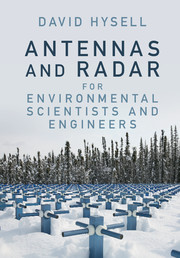Book contents
- Frontmatter
- Contents
- Preface
- 1 Introduction
- 2 Introduction to Antenna Theory
- 3 Antenna Arrays
- 4 Aperture Antennas
- 5 Noise
- 6 Scattering
- 7 Signal Processing
- 8 Pulse Compression
- 9 Propagation
- 10 Overspread Targets
- 11 Weather Radar
- 12 Radar Imaging
- Appendix A Radio Frequency Designations
- Appendix B Review of Electromagnetics
- References
- Index
- References
10 - Overspread Targets
Published online by Cambridge University Press: 09 February 2018
- Frontmatter
- Contents
- Preface
- 1 Introduction
- 2 Introduction to Antenna Theory
- 3 Antenna Arrays
- 4 Aperture Antennas
- 5 Noise
- 6 Scattering
- 7 Signal Processing
- 8 Pulse Compression
- 9 Propagation
- 10 Overspread Targets
- 11 Weather Radar
- 12 Radar Imaging
- Appendix A Radio Frequency Designations
- Appendix B Review of Electromagnetics
- References
- Index
- References
Summary
The signal processing techniques emphasized so far can be classified as “pulse-to-pulse” techniques, deriving spectral information from changes in the scattered signal detected over the course of several interpulse periods. Such techniques are suitable for under spread targets only. Given a low enough radar frequency, a target can often be made to be underspread, and radar engineers may choose the frequency so that simple and effective pulse-to-pulse techniques can be used, even at the expense of other considerations like antenna gain and system noise temperature. However, there are situations where targets cannot be made to be underspread, either because of practical limitations in radar frequency or because of other more fundamental limitations.We saw in Chapter 7 that planetary radar echoes are necessarily overspread in the case of some planets but that pulse-to-pulse techniques can still be applied by ignoring echoes coming from beyond a certain range. This technique is only possible because of the rapid decrease of echo power with range and is imperfect in that it effectively limits the regions of the planets that can be imaged. For most overspread targets, no comparable mitigation strategy exists.
For example, consider radar echoes from meteor heads, or more precisely from the envelopes of plasma surrounding micrometeoroids passing downward through the Earth's upper atmosphere. The echoes are weak and can only be detected with high-power, large aperture radars that operate, for all practical purposes, at VHF frequencies and above. The meteor heads are detected at altitudes between about 80 and 110 km, implying a minimum interpulse period of 200μs for unambiguous range detection. For a 50 MHz radar operating at this IPP, Doppler velocities between ±7.5 km/s are unambiguously detectable with pulse-to-pulse methods. (Since the meteor heads only travel downward, one could argue that descent speeds limited to 15 km/s would be uniquely resolvable.) However, the velocity distribution for meteor heads is broad, and peaks in the vicinity of 50 km/s. Meteor heads are therefore decidedly overspread.
The ionosphere provides another example of an overspread target in the form of modified Thomson scatter (termed “incoherent scatter” by the community that studies it) from free thermal electrons at altitudes above about 70 km.
- Type
- Chapter
- Information
- Antennas and Radar for Environmental Scientists and Engineers , pp. 264 - 287Publisher: Cambridge University PressPrint publication year: 2018



